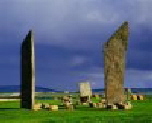|
|
|
|
|
 |
|||||||
|
|
|||||||
|
|
|||||||
|
|
|
Background History Industry Employment Politics Population BackgroundSix miles north of the Scottish mainland, beyond the Pentland firth, lie the 70 islands of the Orkney Archipelago. Twelve are inhabited with others occasionally occupied. most are formed geologically from middle old red standstone, around 400 million years old, not ancient by much of Scotlandís standards. The sandstone was created in the Devonian period of the Paleozoic era through weathering of the great Caledonian mountains, at one time far greater than the Alps today, during the tectonic assembly of the super continent Pangea. This erosion took place over millions of years depositing material in a huge basin called Lake Orcades which at that time was located near the equator. Remnants of this ancient watercourse are now spread around the North Atlantic coasts, with Orkney being the largest chunk. The banding of the sandstone seen today represents sediments being deposited in the lake as it waxed and waned in depth and size over this geological time. More recently, repeated glaciation has smoothed and moulded the rock, and beneficially smeared the islands with fertile boulder clay, which formed the gently undulating, verdant topography we see today. If you are interested in Geology and Landscape formation then visit Orkney Landscape for the most detailed and comprehensive academic information. The sandstoneís and flagstones split easily along bedding planes and were therefore ideal for building purposes. They remained the main building material up until the middle of the last century. A fertile land of well cultivated, gently rolling hills rising to spectacular sheer cliffs along the west and north coasts, Orkney lies at the meeting point of the Atlantic and North Sea where fresh coastal waters are rich in plankton and fish. Sea Cliffs, moors and marshland are usually home to over a million seabirds during the summer, making the islands a Mecca for birders. Recently, bird colonies have been failing due to a lack of basic foods such as Sand Eels, possibly an early indication of world climate change. 80 per cent of the people live on the Mainland, the remainder of the population live on smaller islands ranging from Westray with a population of over 600 to Gairsay, with a single family. Kirkwall (7500) is the main administrative, shopping and population centre of Orkney. Stromness (2500) is second though only about a third the population. Overall, about half the population live in one or other main township. All other villages have between 20 and up to 400 or so inhabitants. (Dounby, St.Margaretís Hope, Finstown, St.Maryís) A considerable number live dispersed in the countryside and about 15% live on the other islands. There are expensive air links from mainland Scotland to Kirkwall Airport as well as daily roll-on/roll-off ferries connections between Scrabster, Gills Bay and Stromness and passenger ferry links connecting John O' Groats and Burwick in South Ronaldsay. There are daily ro-ro ferries to all bar the smallest of the inhabited islands and airfields servicing local flights on Flotta, Hoy/Walls, Westray, Papa Westray, Eday, North Ronaldsay, Sanday and Stronsay. HistoryOrkn-ey (Orkn Isles). Probably Seal Islands. -Ey (or ay/oy) is Old Norse for Island, so NOT Orkney Isles or Islands, or the Orkneys. Has been settled since prehistoric post glacial times, approx. 10.000 bp, when its fertile soils and rich coastal waters supported early man. A wealth of exceptional archaeological sites survive indicating that farming communities began to settle in Orkney during the middle of the fourth millennium BC. During the late first millennium AD the Viking Norse came to dominate Orkney, and used it as a command post for domination over their British/Irish conquests for centuries.The Norse influence lasted well over 500 years until 1468 when the islands were pledged to King James III of Scotland as security for the dowry of Margaret of Norway, his queen. The Old Norse language was slowly replaced by Scots-English, Gaelic never having been spoken in Orkney. Most place names remain today of Norse origin, and many of the locals believe they are of Norse stock. Much further superb information is available on the Web.More recently Orkney was again at the forefront during both World Wars with the huge natural safe anchorage of Scapa Flow taking centre stage. This heritage means that today Scapa is one of the top three world-wide destinations for the Diving fraternity, amongst other things.
|
|
|
